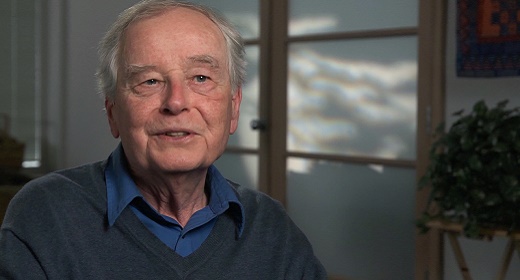by Rick Hanson: Our powerful brains allow us to imagine and evaluate different scenarios in the past and future. But when we shift our attention to the present, our minds can quiet down…
Some years ago one of my neighbors worked in the film industry doing special effects. He showed me a brief clip for one of his projects, of a whale swimming underwater, and he mentioned that the powerful computers at his company had worked overnight to render that single beautiful scene. It seemed remarkable to me that it had taken many hours for their equipment to create a few seconds of imagery that the brain could produce at any time in the theater of imagination.
The circuitry of this inner theater has been one of the major evolutions of the brain over the past several million years. It’s an extraordinary capability that helped our ancestors survive, and it aids and enriches our lives today. But it has some drawbacks, and it’s important to learn how to use it wisely and not let it use you.
Watching Your Inner Movie
Our powerful brains allow us to mental time travel and have a strong sense of self. We draw on our neural networks for what’s called affective forecasting; affective is a psychological term that means “relating to moods, feelings, and attitudes.” This forecasting involves imagining and evaluating different scenarios, such as considering how it would feel to talk with someone in a certain way or simply wondering, “What would taste good for dinner tonight?”
Pause for a moment and consider how much time you spend in the mental activities that draw on these powerful neural capacities. For most of us, it’s a lot. Experientially, we’re caught up each day in many mini-movies in which there is a kind of “I” observing various situations, people, events…and often a “me” to whom things are happening…with lots of thoughts and feelings about the show.
The more a person’s mind wanders, the more it tends to tilt negatively, toward anxiety, resentment, regret, and self-criticism.
This ability, evolutionarily speaking, helped our human and hominid ancestors to get better at learning from the past and planning for the future. But sometimes we just need a break to daydream, which can reveal creative connections and hopeful possibilities. These capabilities have brought many benefits. Still, they’ve come with a price.
These same forecasting systems in our brains can support depressive, self-referential thinking: “I keep messing up. Why am I so stupid/ugly/unlovable?” Our minds can roam all over the place—with both helpful and detrimental results. Studies of people randomly pinged on their cell phone during the day indicate that the average person has a wandering mind about half the time. The more a person’s mind wanders, the more it tends to tilt negatively, toward anxiety, resentment, regret, and self-criticism.
And when we are under pressure and feel threatened—such as during this time of the coronavirus pandemic—it’s natural to get caught up in repetitive loops of rumination: worrying about what might happen, wondering when things will return to normal, getting exasperated with politicians on TV or roommates across a dinner table, and so on.
Coming Home to the Present
But when you shift into another kind of experiencing—simply present in the moment as it is, not judging and evaluating, and with less sense of self—then our forecasting brain can quiet down.
When your mind is wandering about or focused on solving problems, your attention keeps shifting from one thing to another. For example, suppose you see a cookie. The image of the cookie is now a “part” of your consciousness. Next, there is the wish to have the cookie—“Me want cookie!”—which is now a second part of consciousness. Then there is the thought “Oh no, cookies have gluten and calories, not for me”—and a third part is now in the mind. But then another part speaks up: “You’ve worked hard, you deserve that cookie, it’s okay…” Parts interacting with other parts, often in conflict with one another. This is the structure of most of our suffering: parts of the mind struggling with other parts.
Think of something that has bothered you recently—perhaps staying in quarantine, and being bored and anxious, or irritated with other people. Whatever it is for you, consider some of the parts of this experience, and how they push and pull against each other. On the other hand, as a sense of wholeness increases, this inner division and conflict decreases, and suffering decreases as well.
Accepting yourself will help you feel whole, and feeling whole will help you accept yourself.
In this common way of experiencing oneself—parts and more parts—it’s all too easy to push away parts that feel vulnerable, embarrassing, “bad,” or painful. It’s as if the mind is a big house with many rooms, and some of them are locked up for fear of what’s inside. As understandable as this is, it leads to problems. We make ourselves numb to keep the doors bolted shut. But the more repression, the less vitality and passion. The more parts we exile, the less we know ourselves. The more we hide, the more we fear being found out.
Personally, by the time I got to college, it seemed like most of the rooms of my own mind were boarded up. Over the years I’ve had to work on accepting myself—all of myself, every bit, the scared parts, the angry parts, the insecure parts. Through practicing what Tara Brach calls radical acceptance—including accepting yourself—you can reclaim every room in your mind while still acting appropriately. In fact, it is by opening up these rooms that you can best manage whatever they contain. It’s like drawing on two traditional healing tools of a physician: light and air. Accepting yourself will help you feel whole, and feeling whole will help you accept yourself.
Practice: Accepting Yourself
Acceptance means recognizing that something exists as a fact whether you like it or not, with a feeling of softening and surrendering to this reality. For example, this time of uncertainty and loss is all that it is, with its stresses and pains, and meanwhile you can still offer yourself the gift of warm, unconditional acceptance for all that you are experiencing.
- Pick something pleasant, such as a cup you like, and explore the sense of accepting it.
- Do the same with something that is neutral for you, such as a patch of beige carpet, and accept it.
- Then pick something mildly unpleasant—perhaps an annoying noise—and help yourself accept it.
- Know what acceptance feels like. Your body could relax and breathing could ease. There could be thoughts such as “It’s just the way it is…I don’t like it, but I can accept it.” There could be perspective about the big picture and the many causes of whatever you’re accepting. It might help to imagine friends or others who are with you and supporting you as you face what you’re accepting. Be aware of the difference between a feeling of acceptance, which usually has a calming, a peacefulness…and a feeling of helplessness or defeat, which often comes with a sense of frustration, hopelessness, weariness, and depressed mood.
- Pick a positive characteristic about yourself, such as a skill, good intention, or warm feeling. Explore what it’s like to accept this about yourself.
- Next, pick a neutral characteristic such as the fact that you are breathing, and accept it.
- Then pick something you think is mildly negative about yourself and explore accepting it. Try this with several positive, neutral, and negative things about yourself. Gradually raise the challenge level and build the “muscle” of self- acceptance.
- For a few minutes, let things bubble up into awareness, and explore what it feels like to accept them, such as: “Ah, an ache in my lower back, I accept this…loving feelings for a friend, accepting these…resentful feelings about someone mistreating me, accepting them…the sense of a young child inside, accepting that, hello, little one…some scary things down in the basement, wishing they weren’t there but accepting them, too…” Let go of denying or hiding this part of yourself, while also knowing that you can take responsibility for it and act wisely. You might imagine that compassion, kindness, and understanding are touching these parts of you.
- Then, if you like, pick something inside that you are embarrassed or remorseful about, and explore accepting it. Start with something small, establish warmheartedness and self-compassion, and remember that we all have things that are hard to face.
When you accept yourself, there could be a feeling of releasing and easing. Let the walls inside you soften. It’s all right. Let everything flow as it will. Let go of any tension in your body…be aware of breathing…be aware of the front and back of your body as you breathe…relax as a whole being, being whole.










































